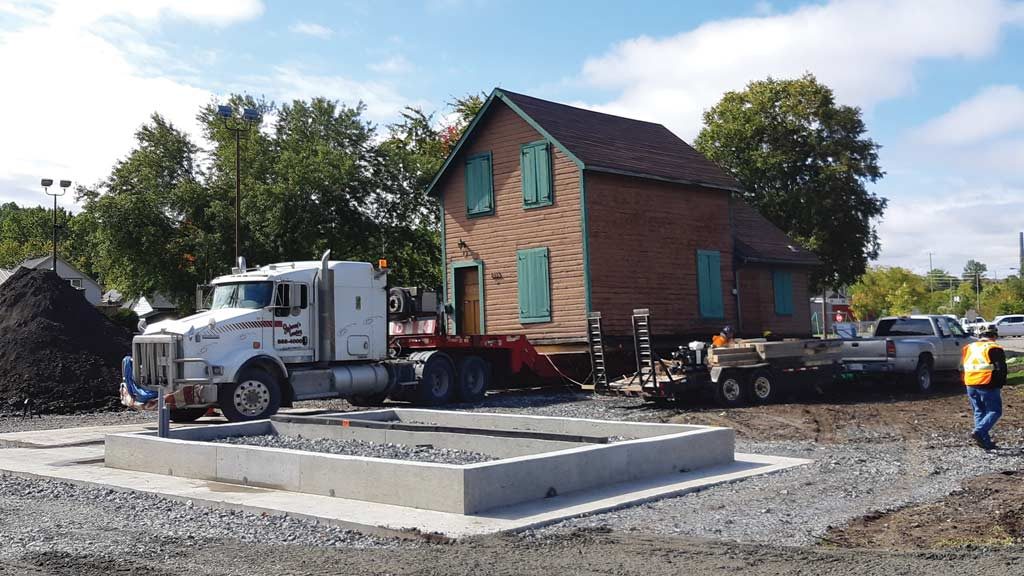Needed sewage infrastructure and heritage preservation have been seamlessly integrated into a three phase project in Sudbury, Ont.’s historic Flour Mill community, which dates back to the 1890s and is considered the heart of the city’s Franco-Ontarian community.
In a closely co-ordinated operation last fall, its Flour Mill Museum, comprised of a heritage house and log cabin, were excavated, lifted onto large trucks and transported a kilometre away to O’Connor Park and placed on new foundations. The contractor was Greater City Concrete Works.
Erected several decades ago, the frame house-sized buildings are considered of historic value and the relocation was the only way they could be saved while allowing Sudbury to proceed with its St. Charles Lift Station project.
Tentatively scheduled to get underway later this year, the project will include the construction of a new lift station and a 1,000-metre-long, 660-millimetre forcemain to connect with the city’s sanitary rock tunnel via a shaft which will have to be excavated through rock, says Sudbury’s water and wastewater projects engineer Akli Ben-Anteur.
In 2009, the old station and existing forcemain were deemed to be nearing the end of their useful life and the building was slated for demolition as it was considered unsafe.
“The lift station is the oldest and largest in Sudbury and the existing forcemain is in bad condition,” he says.
An environmental assessment completed a few years later recommended rebuilding a new onsite station and the construction of a new forcemain. As the museum buildings are on the same site, the recommendation presented some major complications.
“There simply was not enough available room to build the new station,” he explains.
Rather than simply taking the easy route of demolishing the buildings, the city was committed to saving them right from the start, Ben-Anteur says.
In the long lead-up to last fall’s relocation there was considerable consultation and preparation among various municipal departments, the city’s heritage committee, R. V. Anderson Associates Limited, the overall consultant for the lift station project and the community at large.
There were several issues that had to be resolved including the cataloguing, handling and temporary storage of the museum artifacts which include antique furniture, tools, household items and memorabilia. As well, a structural engineering assessment had to be conducted to determine if it was feasible to move the buildings and some structural reinforcement of one building was necessary, he says.
Although the museum’s new home is within the same neighbourhood, the relocation was challenging and lengthy as roads had to be closed and hydro lines disconnected, while keeping the disruption to area residents as minimal as possible. But the move only took a day and hydro service resumed that same day. For now, the structures remain closed while the city prepares integrated approaches that will enhance the experience of visitors to the museum and the park’s other facilities, he says.
Of equal complexity will be the erection of the new lift station and the simultaneous decommissioning of the existing one which has to be kept operating until construction has been completed.
“To do this, we will have to design a bypass system capable of handling existing flows without any impact to residents, businesses and the environment,” he adds.
As for the forcemain, it will have to cross Notre Dame Avenue, a major road with heavy traffic and pass through some challenging terrains along the route to the existing sewer tunnel. To minimize the disruption, trenchless technologies will be used, he says.
At this stage, a contractor has not been selected. But the design is being finalized and the hope is that construction will start later this year. Of course, that depends on how and when the COVID-19 crisis is resolved, says Ben-Anteur.




Splendid work moving our heritage building. Recognizing and supporting our Francophone past has always been important To past council’s.
This new lift station is going to be a historic project. The challenges befit our mining heritage, along with a tip of the hat to our strong engineering
folks at the city.